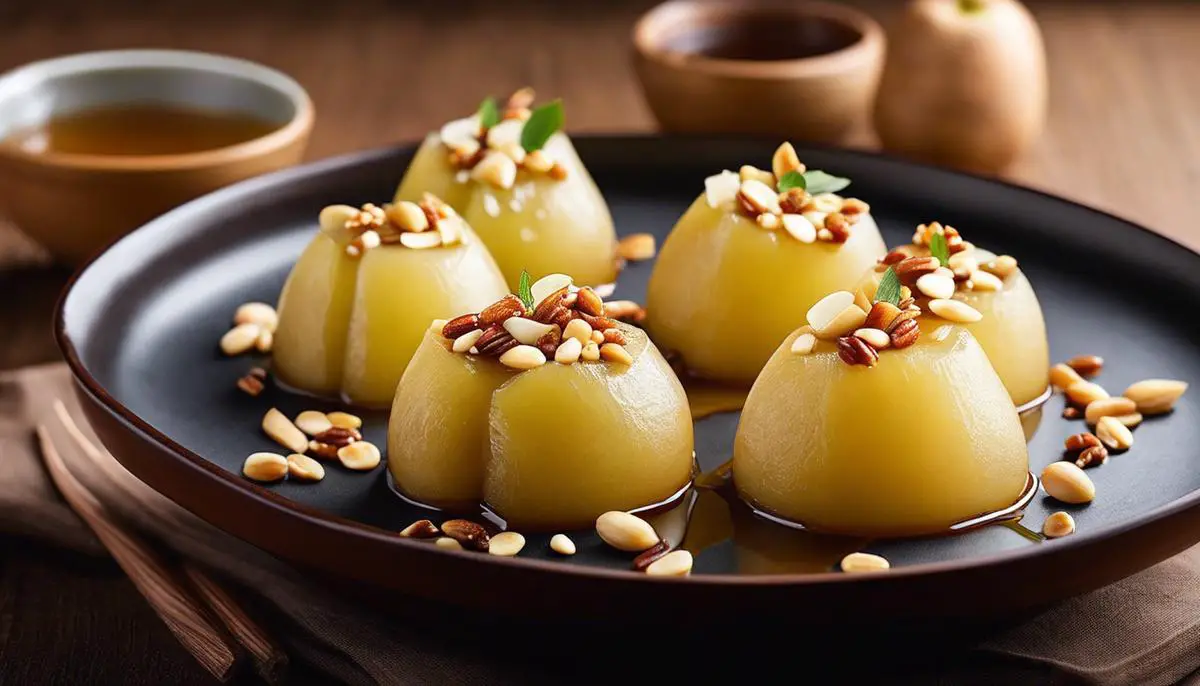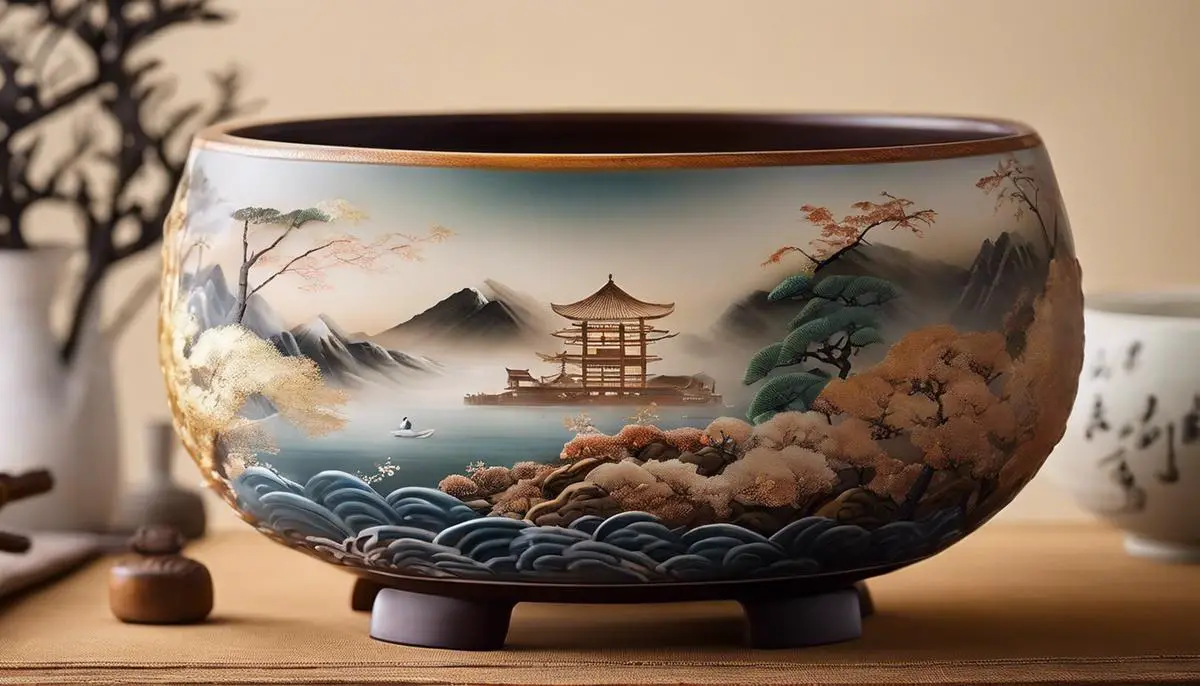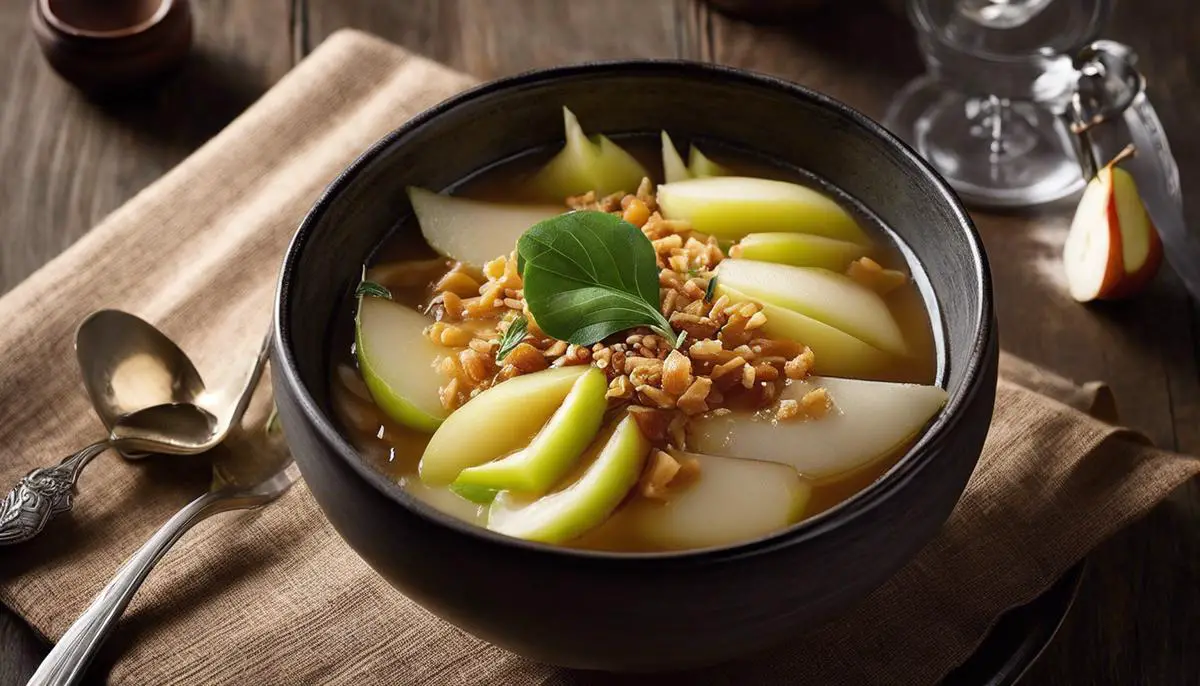
Delving into the heart of Korean culinary tradition, we unearth the gem that is Baesuk, an iconic pear dessert that carries a rich historical legacy. A staple in Korean festivities and gathering, Baesuk extends beyond just a dish — it is a reflection of Korean culture and its love for balanced and harmonious flavors. This exploration takes us through the exciting journey of Baesuk, from uncovering its remarkable history in traditional Korean cuisine to understanding the depth of flavors it brings forth through its key ingredients. Beyond its culinary value, Baesuk also shines in terms of its nutritional aspects and health benefits, making this elegant dessert a healthy indulgence.
History of Baesuk
There is something quite magical about unlocking the rich history and vivid stories within each dish we eat. With every bite, we have the unique opportunity to partake in ancient traditions, taste centuries-old flavors, and experience various cultures without hopping on a plane. And Korean cuisine, with its vibrant flavors and unique recipes, never falls short when it comes to such an experience. One of these mesmerizing dishes, passed down through generations of organized chaos in the warm kitchens of Korean households, is Baesuk, a traditional Korean dessert, and drink.
Baesuk belongs to a category of Korean dishes that encompasses a variety of spicy, tangy, and surprisingly sweet segments of their cuisine that have stood the test of time. The wholesome dessert’s roots run deep within the realm of Korean festivities and social gatherings. It isn’t merely a dish, but a tradition, an homage to heritage, and a celebration of the familial bond.
The term Baesuk breaks down into two syllables, “Bae” meaning pear, and “Suk” referring to a class of Korean dishes cooked by simmering. Primarily, Baesuk is a warm pear punch, made by slowly simmering Korean pears (also known as Asian pears), stuffed with dates, ginger, and honey or sugar, until they look almost translucent and the flavors meld together to create a delectable harmony.
Traditionally, Baesuk had two main uses. It was often served at ancestral rites, called “Jesa,” where Koreans held ceremonies to honor their deceased ancestors. But it also had medicinal uses. Being rich in dietary fiber, Baesuk was believed to be beneficial for digestion, and since the pear and honey infused broth is served hot, it was also a popular remedy for relieving cold symptoms during harsh Korean winters.
Fast forward a few centuries, and despite the whirlwind of modernity, Baesuk has managed to retain its quintessential place in Korean cuisine. It may not be as common in everyday foods, but it’s still an integral part of festivals, social gatherings, and traditional healing methods. In modern Korean households, Baesuk is usually enjoyed as a warm, soothing dessert after a delicious meal or as a comforting beverage during cold seasons.
From a humble home remedy to a celebratory drink, the journey of Baesuk is a testament to the resilience of Korean culinary traditions. While the preparation of Baesuk has seen some tweaks over the years, like adding other spices and using sweeteners like brown sugar, the soul of this dessert remains unchanged. Today, its sweet aroma still wafts through Korean households, carrying tales of yesteryear and whispers of familiarity, while reminding us all – food is not just about sustenance, it’s a language, a cultural identity, and a beloved memento of our shared human history.

Ingredients and Cooking Techniques
Let’s peel back the layers and dive straight into the heart of Baesuk, which is its unique ingredients and cooking process.
First, the magic of Baesuk lies in its simple, yet distinctive ingredients. Predominantly it’s a quince-based dish that brings out the best of the fruit’s fabled flavor. But it doesn’t stop there; it’s spiced with honey for sweetness, while cinnamon and ginger add contrasting warmth, creating a harmonious balance that’s hard to resist. The ingredient list may seem brief, but remember that the magic of food often lies not in the complexity but rather in the harmony that a few choice ingredients can create together.
Secondly, Baesuk relies heavily on a slow-cooking process. Instead of speeding through the cooking process, this gem of the Korean culinary world is poached slowly on low heat, allowing the ingredients to release their flavors gradually. This process helps to enhance the quince’s unique sweetness and extract the warm, spicy notes of ginger and cinnamon fully. The slow-brewing process not only gives Baesuk its unique aromatic scent but also gives the quince pieces their signature tender, jelly-like mouthfeel.
But how does one smoothly fuse these elements at home?
The answer lies in patience and respect for the ingredients. Taking the time to delicately peel and quarter the quince, then simmer gently with its companions of honey, ginger, and cinnamon on low heat for a prolonged period is essential. The reward is the luxurious blend of sweet-sour quince with spiced undertones resulting in a multi-layered dessert that warms both your taste buds and heart.
To make sure that quince keeps its form and doesn’t turn mushy, keep an eye on it towards the end of the simmering process. It’s worth mentioning that the quince seeds, packed with pectin, can be tossed in to provide an all-natural thickening effect to the resulting syrup.
Don’t rush the cool-down process either. Baesuk is best served slightly chilled. After cooling at room temperature, you can stash it in the refrigerator to reach a refreshing chill. Alternatively, serve the poached quince as a dessert, and use the left-over spice-infused syrup as a hot drink.
The beauty of Baesuk lies in its versatility. On cold days, it could be your comforting, palate-warming beverage and on others, it could be a subtly sweet and tangy dessert. It acts as an ideal embodiment of Korean cuisine’s essence, where modest ingredients, when paired with the right cooking method, can produce a unique, soul-satisfying culinary treasure. Without a shadow of doubt, Baesuk is much more than just a traditional Korean dish, it’s an experience worth savoring, a memory worth making. So go ahead, give it a try, and let the magic of Baesuk charm you!

Culinary Affinity & Pairing
Diving headfirst into the culinary journey of Baesuk can open the doors to a panorama of flavors that are reflective of the rich heritage of Korean food culture. Every sip of this warm and comforting dessert elixir sends a tantalizing wave of velvety goodness infused with a balance of sweetness and depth, and a surprise element of crunch delivered by the pear slices.
One of the most enjoyable ways to savor Baesuk is not only by slurping it straight from the bowl or sipping it from cups but also using it as a delightful pairing. The art of food pairing is all about balancing the flavors and textures to create an unforgettable culinary experience. Baesuk, with its semi-sweet profile, naturally lends itself to coupling with both sweet and savory dishes.
A popular accompaniment to Baesuk could be the spicy and tangy flavors of Kimchi. The fragrance of Baesuk plays off nicely against the potent tang from the fermented cabbage, creating a culinary duet that is an absolute pleasure for the senses.
Consider following this warm beverage with the hearty bulgogi, slow-cooked and marinated Korean beef. The spicy, sweet, and savory characteristics of the bulgogi play well with the subtle tones of Baesuk, enhancing its mild and comforting notes. It’s like a comforting hug in the middle of a meal!
For dessert, a slightly tart, fresh fruit such as raspberry or blackberry, or a subtler fruit like a ripe peach or plum, could spectacularly offset the sweet and warming notes of Baesuk.
As for the beverage pairing, a cup of the mildly bitter, refreshingly aromatic green tea could serve as a wonderful palate cleanser, perfectly wrapping up a flavoursome course. A glass of smooth plum or raspberry wine, which echoes the fruity sweetness of Baesuk without overwhelming it, could also compliment your lunch or dinner.
Baesuk is not just a dessert or a drink; it’s a sensory journey woven into Korean traditions that offers a unique communion of history, food, and human connection. The simplicity of its humble ingredients, the versatility of its profile, and its significant place in Korean households and festivities make Baesuk more than just a dish; it’s an experience that flavor-chasers will find memorable and one that they will find joy in repeating.

Nutritional Value & Health Benefits
Venturing into the nourishing world of Baesuk, it’s imperative to touch on its nutritional bounties and the health benefits that this delightful concoction presents.
Baesuk, primarily composed of simple, yet healthful ingredients such as Asian pear, honey, and ginger, serves as a rich dispenser of a wealth of nutrients. The Asian pear, a significant component of this dish, is not merely a delightful savor but is also rich in vitamins C and K, along with essential micronutrients. These vitamins are known powerhouses for enhancing immunity, contributing to bone health, and improving overall well-being.
Ginger, a cornerstone spice in Korean cuisine manifests potent health benefits, woven beautifully in Baesuk. Famously enshrined for its anti-inflammatory and antioxidative properties, it aids digestion, reduces nausea, and may help ward off chronic diseases. In essence, Baesuk provides a pleasant and enjoyable way to relish ginger’s abundance of nutrients and therapeutic qualities.
Moreover, the generous drizzle of honey that is characteristic of Baesuk doesn’t just sweeten the pot but also adds a healthful touch. Notorious for its antimicrobial properties, honey also acts as a natural and healthier substitute for refined sugars. It aids in soothing sore throats, making Baesuk a comforting natural remedy during chilly winters or flu seasons.
Embracing the tradition of using food as medicine in Korean culture, Baesuk finds its place in modern wellness trends. The harmony of Asian pear, ginger, and honey generates some serious wholesome refreshments that may help strengthen the immune system, support gut health, and even contribute to heart health through its antioxidative properties.
The introduction of other ingredients such as jujubes and pine nuts to some recipes of Baesuk, only adds to its nutrient composition. Jujubes, for instance, are a rich source of vitamins, minerals, and antioxidants, while pine nuts are packed with healthy fats, proteins, and various plant compounds beneficial for heart health.
In essence, Baesuk is not merely a delightful food experience that pays tribute to the eloquent aspects of Korean culinary artistry, but also a promising health-giving elixir. Its nourishing attributes are hidden behind its humble ingredients and the simply joy of savoring it. Therefore, Baesuk stands as a stunning testament to the prominence of food’s healing nature in Korean culture, beyond its lip-smacking goodness.
Ultimately, the pleasure derived from a dish of Baesuk is twofold — the delight of savoring a concoction that warms the soul and cheers the senses, paired with the nourishing richness that embraces the body, making it a holistic culinary experience to cherish.

Regardless of variations in recipes and slight shifts in preparation methods, Baesuk continues to express an essence of Korean culture, enveloping taste and tradition in each bite. With its blend of simple ingredients and unique flavors, this dish provides a culinary experience that stays true to its roots while satisfying modern palates. Beyond its appeal as a delightful dessert, Baesuk presents itself as a treasure trove of nutritional benefits, becoming an indulgence that is as healthful as it is tasty. As the beautiful symphony of flavors in Baesuk meld to create a taste unmatched, it truly exemplifies the magic of Korean gastronomy.



